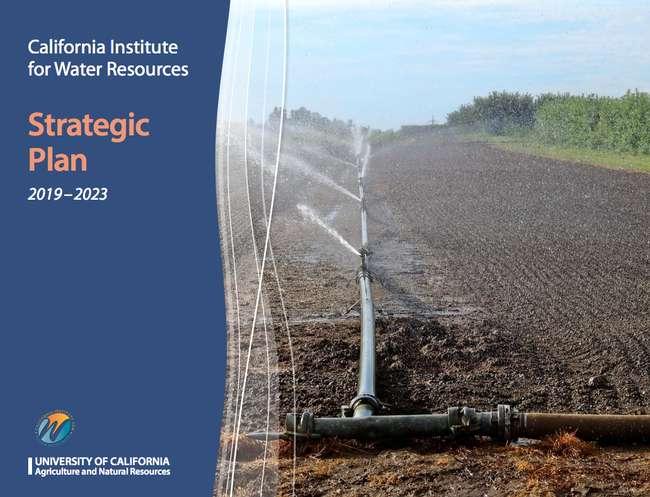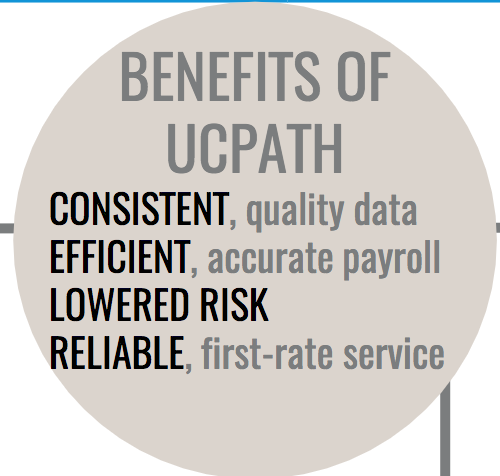Posts Tagged: California Institute for Water Resources
Water institute calls for research proposals
The California Institute for Water Resources invites submission of proposals to be considered for funding that will begin March 1, 2021.
This year, proposals are requested in the Junior Investigator category only. Funding is for up to two years. One-year proposals may request up to a total of $15,000, and two-year proposals may request up to $25,000 with a maximum of $15,000 in a given year.
Please note that the funding period may fluctuate and is contingent on state and federal budget appropriations.
The 2020-21 water resources research proposals are due Oct. 30, 2020, at 5 p.m.
Download the full RFP and budget worksheets (Word or PDF).
California Institute for Water Resources drafts new strategic plan
The committee was carefully selected to represent the diverse stakeholder interests of the institute. Through a variety of inputs during an assessment phase, which included several stakeholder surveys, committee members gathered information to help identify the strengths, opportunities and challenges of the organization to help formulate the plan. The final plan is a living document, which will be used as a flexible framework to develop annual priorities and evaluate progress.
The mission of the California Institute for Water Resources is to integrate California's research, extension and higher education programs to develop and communicate research-based solutions to water resource challenges. CIWR directly impacts California water issues through research and extension programs. The institute keeps its partners informed through its website, newsletter, blog and social media outlets and actively contributes, shapes and diversifies the conversation on California water issues. Meeting the objectives set forth in its strategic plan will increase the effectiveness of CIWR in helping California meet its future water challenges.
CIWR identified five strategic goals to focus on over the next five years:
- Foster and incubate research and extension focused on California's critical water challenges.
- Engage with and convene the water community to define and address California's water challenges.
- Enhance communication and engagement capacity and increase visibility.
- Strengthen the relationship between CIWR and UC ANR.
- Increase resources to better incubate research and engage the water community.
The complete plan is available at http://ucanr.edu/CIWRStrategicPlan or by visiting CIWR's website: http://ciwr.ucanr.edu.
Communication is key to action on California’s new water narrative
UC scientists, students and water agency professionals took a critical look inwards and a radical look outwards when they gathered in Sacramento in October to reimagine California water.
The event was the fourth annual gathering sponsored by UC ANR's California Institute for Water Resources and the University of California Water Security and Sustainability Research Initiative, UC Water.
While science is the hallmark of a research-oriented institution like UC, the participants were asked to recognize their important role not just as scientists but also communicators.
“We have a big role in educating the public,” said Roger Bales, engineering professor at UC Merced who has been active in water and climate research for more than 30 years. “Scientists are political actors. Facts do not speak for themselves.”
Felicia Marcus, chair of the California Water Resources Control Board and a conference panelist, asked the scientists to make their work accessible, and if they are uncomfortable with plain language, “write it both ways.”
“Complexity can lose people easily,” she said.
The conference keynote speaker, futurist Kim Stanley Robinson, also addressed the divide between scientific discourse and popular understanding, in particular when speaking about climate change.
“There is a strange disconnect between what the scientific community is telling the world and what the world is hearing. As a result of data analysis, science is announcing to the world there is climate change. Individuals cannot perceive climate change,” he said. “Show them in ways that can be understood by the senses. The story has to be told with pragmatism and common sense.”
The Reimagining California Water Conference pursued the water journey from the high-mountain headwaters of the Sierra Nevada to the vast groundwater basins in the valleys below. Over the last century, the mountains were blanketed with snow each winter, storing water that melted slowly in the spring and summer to provide a reliable source of water for farming and communities below. However, climate change is telling a new tale. Warmer weather means less snow and more rain will fall on the mountains during the winter. The quick runoff must be managed in a way that preserves it for use in the summer.
“We need groundwater recharge because we're losing the snow pack quicker than we thought we would,” Bales said.
The new California water narrative has prompted scientists and policymakers to take a serious look at the potential for “flood-managed aquifer recharge” or Flood-MAR. Flood-MAR is a management strategy that uses water from rain or snowmelt to flood agricultural lands and working landscapes, such as refuges, floodplains and flood bypasses.
Successful implementation of Flood-MAR requires the identification of land for groundwater recharge, understanding the economic and agronomic impact of using agricultural land for recharge, and impacts of high-volume recharge on groundwater quality. But the potential is enormous.
“The state's underground basins are capable of storing 500 million acre-feet of water,” said Graham Fogg, UC Davis professor of hydrogeology. “That's like 500 Folsom reservoirs.”
Though the enormity of rewriting the California water story might seem an insurmountable challenge, panelist Debbie Franco noted that the passage of Sustainable Groundwater Management in 2014 happened when the state's unsustainable reliance of groundwater spiked during the 2011-2016 drought, reducing municipal water quality, drying domestic wells and causing land to sink.
“What seems impossible, after four years of drought, can be possible,” Franco said. “What will be the next thing? Get a sense of the solutions now.”
Final position proposals due Sept. 15 for 2018 Call for Cooperative Extension positions
On Aug. 1, phase 2 of the Cooperative Extension Positions Call process ended and phase 3 began. During phase 2, the Program Teams reviewed the 40 phase 1 proposals and submitted six additional proposals. All submitted proposals are posted on the 2018 Call for Position web page: http://ucanr.edu/2018callforpositions.
Phase 3:
- The statewide programs and institutes are now reviewing all 46 proposed positions to determine if there are any positions they feel are of higher priority.
- If so, they can propose up to two additional CE advisor positions and two additional CE specialist positions by Sept. 15 – keeping in mind that the more proposals there are at the end, the lower the probability of being approved for recruitment.
- The proposals that did not make the phase 1 final 40 can be picked up during these subsequent phases. They can be found on the proposal ideas web page. New proposals are not limited to these ideas.
After Sept. 15, Program Council will review all the feedback and make recommendations to the vice president.
“We thank the ANR network for actively engaging in this participatory process to strengthen and rebuild CE positions statewide,” said Wendy Powers, associate vice president.
ANR to join UCPath next spring
Preparations are underway for UC ANR to join UCPath in the spring. To ensure a successful transition to new systems and new processes, John Fox, executive director of Human Resources, recently hosted the first in a series of monthly meetings with business officers and administrative staff located in UC Cooperative Extension offices, at Research and Extension Centers and in administrative units.
UCPath is a systemwide initiative launched by the University of California to modernize its current payroll system, which is nearly 40 years old. Using new technology, UCPath will unify and standardize payroll, benefits and human resource systems for all UC employees.
Employees at Office of the President, UC Merced and UC Riverside have already made the transition. UCLA and UC Santa Barbara are scheduled to join UCPath this fall. UC Berkeley, UC Davis, UC Irvine and UC ANR are scheduled to join in April 2019.
This initiative involves a single payroll and HR technology system, a shared services center in Riverside, and the formation of UC ANR as a distinct business unit within UC. The formation of UC ANR as a stand-alone business unit, rather than as part of UCOP or a campus, is one of the strategic initiatives supported by President Napolitano, and provides an opportunity to improve efficiency and strengthen compliance and accountability.
“UC Path will transform the way we do business,” said Fox. “Our fiscal silos will be unified, hugely improving the accuracy of our fiscal data and the speed with which we can access it. It will also give all of us better access to information and improved tools for hiring and transaction approvals.”
Business officers and administrative staff will be key to the success of UCPath for ANR.
“They are the people who know how to get things done in ANR today,” Fox said. “We want to support them in becoming UCPath experts to help ANR employees navigate the new systems and processes.”
Business officers and administrative staff who missed the UCPath Network kick-off Zoom meeting with Fox can view a recording of the Aug 24 session at https://ucdavis.app.box.com/v/ucpathnetwork. The next monthly session will be on Wednesday, Sept. 26, 11 a.m. to noon.
Highlights of UCPath when it goes live in spring 2019:
- User-friendly, mobile-enabled portal to view and update personal data and manage benefits
- The UCPath Center in Riverside will help with benefits, payroll and personnel services
- Direct deposit in up to three accounts
- New recruitment tools and enhanced candidate experience
- Manager self-service access to reports and employee data
- Improved security for payroll and personnel data
- Automated routing for approval of personnel and certain pay transactions
- Improved online employee appraisal system
- Standard set of reports provided to all UC business units
Academics who are affiliated with a campus should refer to their respective campus UCPath websites. More information is on UC ANR's UCPath website at http://ucanr.edu/UCPath and it will continue to be updated as we approach the launch.
An email account has been set up to receive questions and comments about UCPath: ucpath@ucanr.edu.




